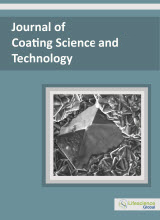jcst
|
|
| Abstract: In polymer extrusion, compounding is a continuous mixing process that is also used to produce highly reactive powder coatings. A premixed batch of powder coating is added to the feeding section and extruded, preferably by a co-rotating twin-screw extruder. One essential parameter in the processing of highly reactive materials is the melt temperature: If it is too high, pre-reactions occur during the extrusion process, which may cause high rejection rates. We studied the melt temperature of an epoxy/carboxyl-based powder coating using a retractable thermocouple at 3 different axial positions along the barrel of a ZSK34 co-rotating twin-screw extruder. The influence of different processing conditions on the reactivity of a highly reactive powder coating was examined by infrared spectroscopy and differential scanning calorimetry. Furthermore, the specific energy input and the color change in the finished powder coating at different processing points were investigated. Multivariate data analysis was used to correlate mid-infrared spectra, melt temperatures, specific energy inputs, enthalpies of reaction and changes in color.
Keywords: Extrusion, twin screw, infrared spectroscopy, ATR, DSC. |
|
|
|
Abstract: Growth aspects of pure and Calcium doped Zinc hydrogen phosphate single crystals from silica gel by the process of single diffusion technique are discussed. Crystals with different morphologies and effect on various parameters like gel pH, and gel ageing, gel density and concentration of reactants on the growth of pure and Calcium doped ZnHPO4 crystals were studied. Laser Raman spectra of the pure and Calcium doped ZnHPO4 crystals are recorded and the vibrational assignments have been made with possible explanations. Thermo gravimetrical analysis is undertaken to study the thermal stability of the grown crystals.The photoluminescence measurement shows that the material is suitable for photonic devices. The crystals grown were characterized by Laser Raman spectrum, TG/DTA, EDAX and Photoluminescence. Keywords: Gel technique, TG/DTA, EDAX, Laser Raman, and Photoluminescence |
|
|
|
Abstract: Growth aspects of pure and Calcium doped Zinc hydrogen phosphate single crystals from silica gel by the process of single diffusion technique are discussed. Crystals with different morphologies and effect on various parameters like gel pH, and gel ageing, gel density and concentration of reactants on the growth of pure and Calcium doped ZnHPO4 crystals were studied. Laser Raman spectra of the pure and Calcium doped ZnHPO4 crystals are recorded and the vibrational assignments have been made with possible explanations. Thermo gravimetrical analysis is undertaken to study the thermal stability of the grown crystals.The photoluminescence measurement shows that the material is suitable for photonic devices. The crystals grown were characterized by Laser Raman spectrum, TG/DTA, EDAX and Photoluminescence. Keywords: Gel technique, TG/DTA, EDAX, Laser Raman, and Photoluminescence. |
|
|
| Abstract: Iron aluminides (Fe3Al and FeAl3) coatings were fabricated on a steel substrate by self-propagating high temperature synthesis (SHS) method. Raw materials, Fe and Al powders, were mixed at two different stoichiometry ratios (3:1 and 1:3). The mixtures and the substrate were placed in a furnace at 950 °C to ignite the SHS process. Coating phases were investigated using X-ray diffraction (XRD) and Energy Dispersive Spectroscopy (EDS). The microstructure of the coatings was analyzed with optical microscopy (OM) and scanning electron microscopy (SEM). The results confirmed that it is possible to produce Fe3Al and FeAl3 coatings on steel substrate using SHS method. In addition, the results show that the coatings were composed of two different phases and their microstructures were non-porous and dense. Wear resistance of the coatings were higher than that of the substrate.
Keywords: Iron Aluminide Coating, Fe3Al, FeAl3, Low carbon steel, Self-propagating high-temperature synthesis (SHS), SEM, XRD, Wear test. |
|
|
|
Abstract: The effect of micro-precoating on temperature distribution of the plasma thermal spraying was simulated. After the plasma thermal spraying test with SS304 as precoating, the effect of micro-precoating on the wear loss and fatigue had been studied preliminarily. Results show that the surface temperature with micro-precoating is higher than that of without micro-precoating. Meanwhile, the heat affected zone with precoating is wider which effectively restrains the microcracks forming in the succedent coating. Subsequently, the wear and fatigue of the plasma thermal spray coating are significantly increased with the optimum micro-precoating thickness. Keywords: Simulation, Temperature distribution, Micro-precoating, Thermal spraying. |


